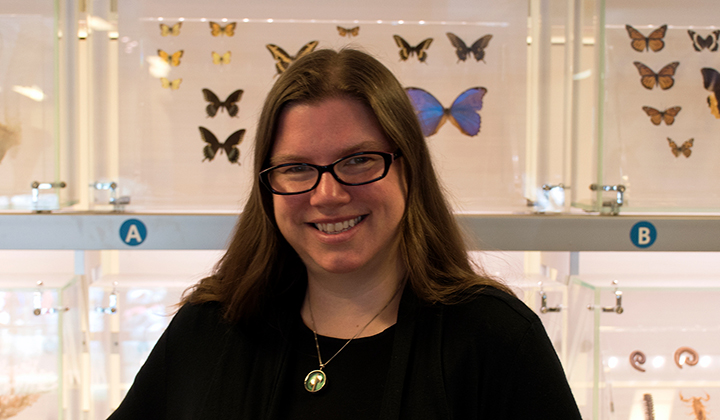Communications Associate Translates Bench Science for an Eager Audience
BY SUZANNE FLINCHBAUGH | OCTOBER 20, 2020
BMB’s Communications Associate Shares the Power and Wonder of Science
Explaining tarantula behavior to wide-eyed children (and adults!) gathered around her at the Insect Cart, Sarah Studer was in her element, volunteering at the Smithsonian. As an “insect ambassador” for the National Museum of Natural History, she was doing what she loved best, talking about science with the general public. She just wanted to find a job that focused on that too.

When a listing for a newly created communications associate position at the Bloomberg School’s Department of Biochemistry and Molecular Biology popped up in her job search results, she was intrigued. Applicants needed a deep science background, excellent communication skills, and a talent for explaining the nuts and bolts of the scientific process to the general public. Bingo! Studer successfully interviewed for BMB’s new communications associate position and joined the Johns Hopkins staff in July 2019.
One year and a pandemic later, Studer has settled comfortably into the job. Funded in part by a gift from the Walder Foundation, her role is split between BMB and the lab of Associate Professor Scott Bailey, whose CRISPR research is also supported in part by the foundation. She is thrilled to be tasked with communicating about the department, with its broad range of research. “I feel like a kid in a candy shop because I get to learn new things all the time, and then I get to share some of what I learn with all types of audiences,” Studer commented with a laugh.
Her passion for science has never wavered since she was a kid growing up in Portland, Oregon, prowling the halls of the Oregon Museum of Science and Industry. Even so, while completing her PhD in microbiology at the University of Wisconsin–Madison, she realized that she was more interested in communicating science than in creating it. In 2011, Studer started a science policy fellowship and quickly found that she enjoyed the intersection of science and the world outside the lab. But what she really relished was translating science topics—whether explaining the results of microbiology research or demonstrating at a science festival booth how fuel cells work.
Clearly and simply communicating complex scientific findings and their applications is part of her role in BMB, and her ability to convey that information and direct people to other resources is key. “I see myself as a bit of tour guide,” Studer said, "helping people find their way through complicated material to learn something new."
She recently wrapped up the first iteration of a CRISPR Primer with Bailey, a project that was one of the communication goals of the Walder Foundation gift. CRISPR is a hot topic because of its use in gene editing. “But what most people don’t hear about is that CRISPR systems are actually immune systems used by microbes,” Studer said. “That aspect fascinates me, so I was excited to get to work with Scott, who studies how these systems function at the molecular level.”
The Primer is aimed at people with some background in molecular biology. It describes a range of CRISPR topics, from how the systems work to defend microbial cells against viral infections to how the characteristics of different systems make them useful for molecular biology tools. “I hope the Primer gives others a solid understanding of the basics of these systems, and some pointers of where to go next if they want to learn more,” Studer said.
This is just the start of the Primer, which Studer and Bailey plan to expand and update as researchers publish new findings.
In addition to the Primer, Studer also develops communications for the department, managing the website, writing news stories about faculty and alumni, and showcasing faculty research.
“I enjoy writing Twitter threads about newly published papers,” she said. “I read the paper and then figure out how to give BMB’s audience enough insight to understand why it’s interesting, while not drowning them in jargon or too many details.” Working with the papers’ authors lets her learn about especially interesting results and check that she gets the details right.
The School is fortunate to have such a talented communicator in its ranks. As an ambassador for the basic sciences, Studer is doing what she does best: sharing the wonder and power of science.
Suzanne Flinchbaugh is a senior writer in the Office of External Affairs at the Bloomberg School. To learn more about how to support the Department of Biochemistry and Molecular Biology or to discuss making a gift, please contact Alice McMurry, senior director of principal and major gifts, at amcmurr6@jh.edu.
